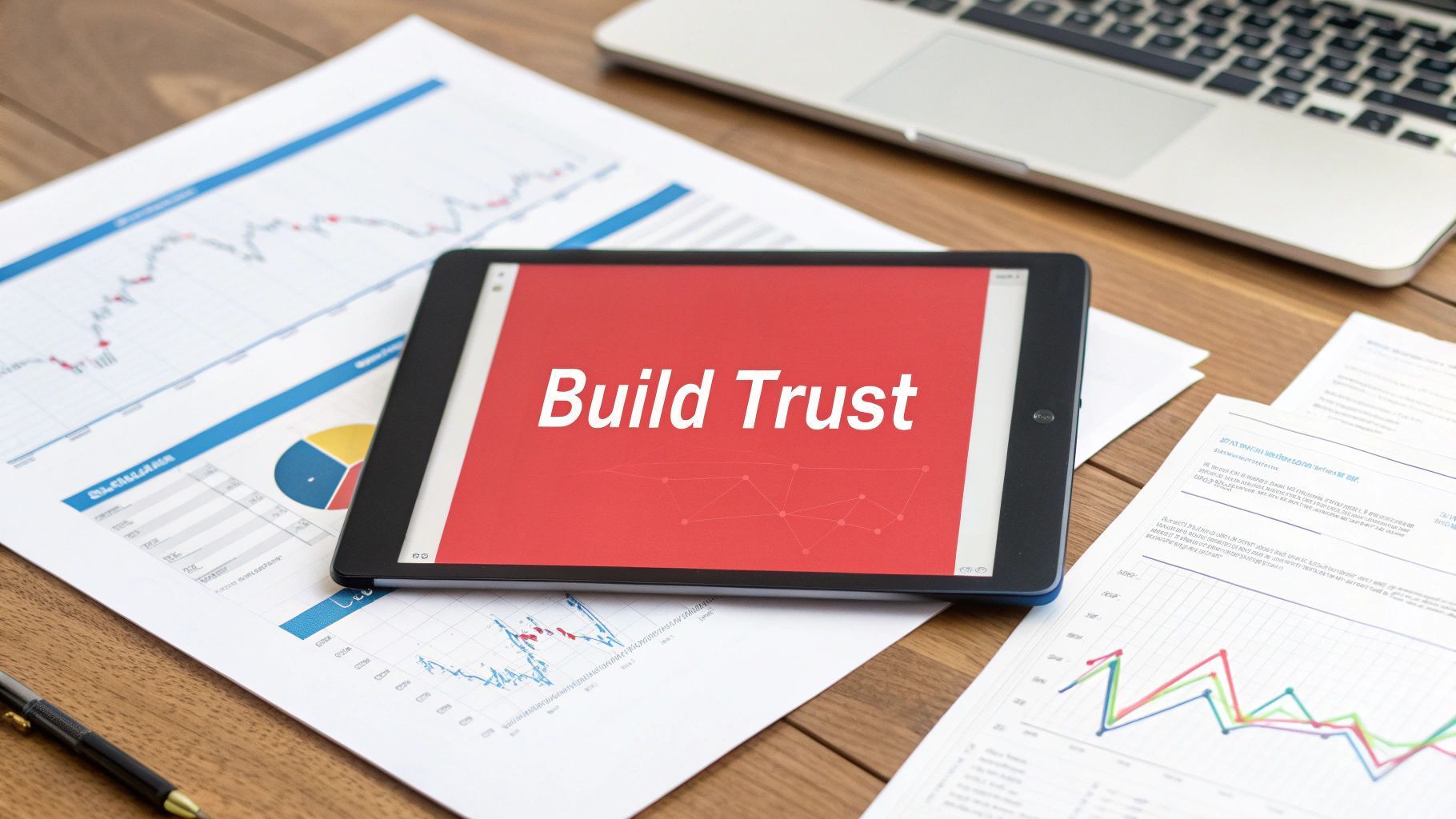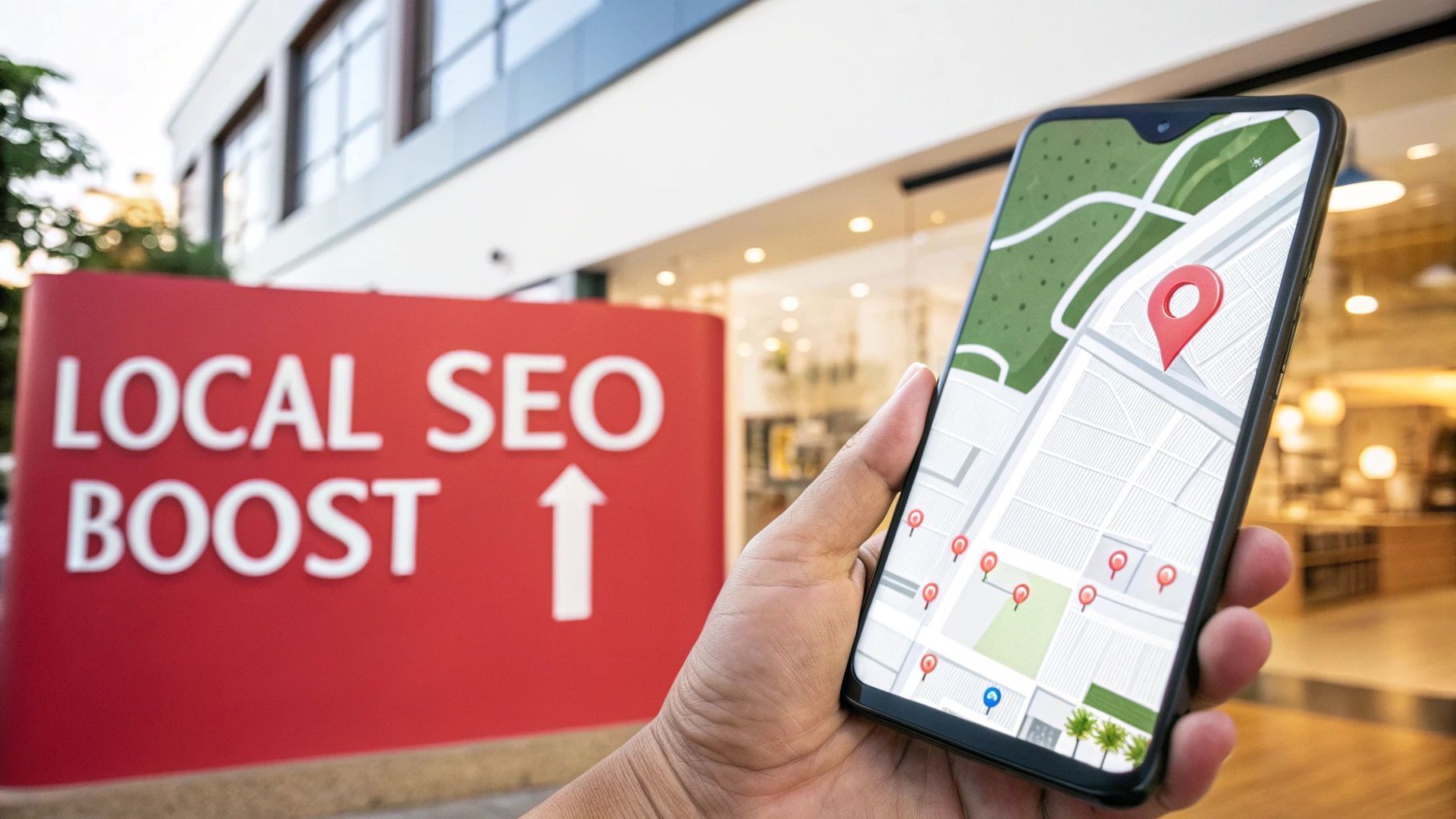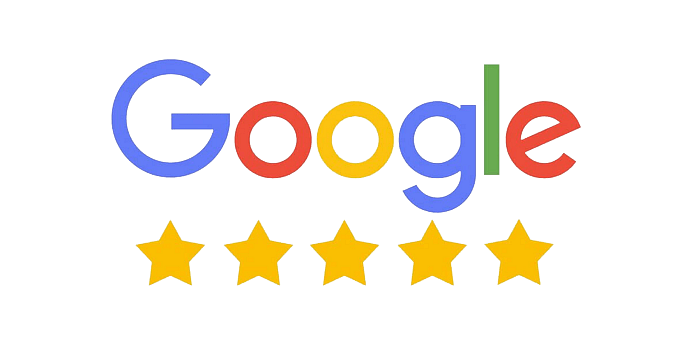Digital marketing solutions that grow your business
When people talk about “digital marketing solutions”, it’s easy to think of some single, complicated service. The reality is much simpler. Think of it as a builder’s toolbox for growing your business. Inside, you have specific tools like SEO or content marketing and while each has its own job, they’re designed to work together to bring in customers and boost your bottom line.
Demystifying digital marketing solutions
The key isn’t to use every tool at once. It’s about picking the right ones for the job you need to do. A digital marketing solution is simply the unique collection of these disciplines, all working together as part of a single, integrated plan.
For instance, a local bakery is not going to need the same setup as a national software company. The bakery might lean heavily on social media to post its daily creations and use local SEO to pop up when someone nearby searches for "fresh bread". The software company, on the other hand, would probably focus more on in-depth content marketing and LinkedIn ads to establish its authority and capture leads.
Each business uses a different mix of solutions to get the results it needs. The real power is in making sure every piece of the puzzle fits together.
The strategic blueprint for growth
It’s a common mistake to think a marketing strategy is the same as a marketing tactic. They’re two different things but they’re completely connected.
- Strategy: This is your long-term vision. It answers the big "what" and "why" questions. Your strategy might be to become the go-to motorsport sponsor recruiter in the UK.
- Campaigns: These are the focused, short-term projects that bring your strategy to life. A campaign could be a three-month push on social media to showcase your most successful partnerships.
- Tactics: These are the specific, day-to-day actions you take. A tactic would be writing a blog post about a sponsored driver or running a highly targeted ad on LinkedIn.
Getting these layers right is essential. It ensures that every small action you take is deliberately moving you closer to your main goal. If you're curious about how this all comes together in practice, our guide on what a digital marketing agency does breaks down how professionals manage these moving parts.
Why it matters for UK businesses
In a market as competitive as the UK, having a solid digital presence is non-negotiable. The UK’s digital advertising market was recently valued at around £33 billion and it's not slowing down. This isn't just a trend; it's a fundamental shift in how businesses connect with their customers.
The market is expected to grow at a compound annual growth rate of 15.1% through 2030, potentially hitting a staggering £77 billion . Mobile is leading the charge, with smartphones already making up over 58% of all digital ad revenues.
What does this tell us? If you’re not online, you’re invisible to a massive and growing audience.
At their core, digital marketing solutions provide the framework needed to find, engage, and turn your ideal audience into loyal customers. Often, this involves integrated systems like a CRM for digital marketing to manage those relationships from the first click to the final sale. It’s the engine that powers modern business growth.
The three pillars of online visibility

To get noticed online, you need a solid foundation. Just like a building needs strong supports to stand tall, a powerful digital marketing strategy is built on three core pillars: Search Engine Optimisation (SEO), Pay-Per-Click (PPC) advertising, and Content Marketing.
Each pillar has its own job to do but they're at their strongest when they work together. Understanding how each one functions is the first step towards building a marketing plan that actually delivers sustainable growth.
Let’s break them down, without the confusing jargon.
Search Engine Optimisation: The foundation of discovery
Think of SEO as making your shop the easiest one to find on a busy high street. It’s all about fine-tuning your website so that search engines like Google put you in front of people who are actively looking for what you offer. This isn't about quick tricks; it's about building long-term authority and trust.
When someone searches for a product or service you provide, showing up on that first page of results is everything. SEO involves a whole range of activities designed to send clear signals to search engines that your website is a credible and valuable answer to that person’s search.
This process builds what we call organic visibility . It means you earn your spot through quality and relevance, rather than paying for it directly. It’s a long-term investment that pays dividends over time, delivering a steady stream of the right kind of traffic to your site.
Pay-Per-Click advertising: The growth accelerator
If SEO is the long game of earning your spot on the high street, PPC is like paying for a massive billboard in a prime location. It gets you immediate visibility by placing your ads at the very top of search results or on social media feeds. The best part? You only pay when someone actually clicks on your ad.
This makes PPC a potent tool for any business that needs to generate traffic and leads, fast. It's also highly measurable, letting you see exactly what you're spending for every single click and conversion.
PPC campaigns also offer incredible targeting. You can aim your ads based on specific keywords, demographics, locations, and even what people have been browsing for. For a new product launch or a seasonal promotion, that ability to drive immediate, targeted traffic is priceless.
Content marketing: The engine of engagement
Content is the fuel for both your SEO and PPC efforts. It's the practice of creating and sharing valuable, relevant, and consistent content to attract and keep a specific audience. This isn't about the hard sell; it’s about building relationships and positioning your brand as a helpful expert.
Imagine you own a garage that specialises in classic cars. Your content could be blog posts on restoration tips, videos showing off your work, or guides on sourcing rare parts. This material doesn't just sell your services; it proves your expertise and passion, building a community around your brand.
Great content answers your audience's questions, solves their problems, and builds trust. It provides the substance that makes your SEO efforts effective and gives your PPC campaigns something valuable to direct traffic towards.
This approach turns your marketing from an interruption into a welcome resource. The numbers in the UK back this up. With digital advertising revenue projected to exceed £40 billion , businesses are investing heavily in a mix of strategies. For instance, 77% of UK businesses invest in SEO, while 65% use paid search to target active customers. You can explore more UK digital marketing facts to see the full picture.
How the three pillars work together
These pillars aren't separate strategies; they're interconnected parts of a single, powerful machine. A truly effective digital marketing solution weaves them together to create a result that’s far greater than the sum of its parts.
Think about the synergy:
- PPC data informs SEO: You can use a PPC campaign to quickly test which keywords bring in the best customers. That data then feeds your long-term SEO strategy, so you're not just guessing which terms to target.
- Content fuels both channels: High-quality content is the backbone of SEO rankings. It also gives you something genuinely useful to share in social media posts and becomes the destination for your PPC ad clicks.
- SEO improves PPC performance: A well-optimised website—a core part of SEO—earns a higher Quality Score in Google Ads. This can lead to lower ad costs and better ad positions.
By combining these elements, you create a self-reinforcing cycle of growth. SEO builds a sustainable foundation, PPC drives immediate results while gathering data, and content marketing engages your audience and builds your authority. Together, they form a robust framework for attracting, engaging, and converting customers.
Building relationships through social media and email
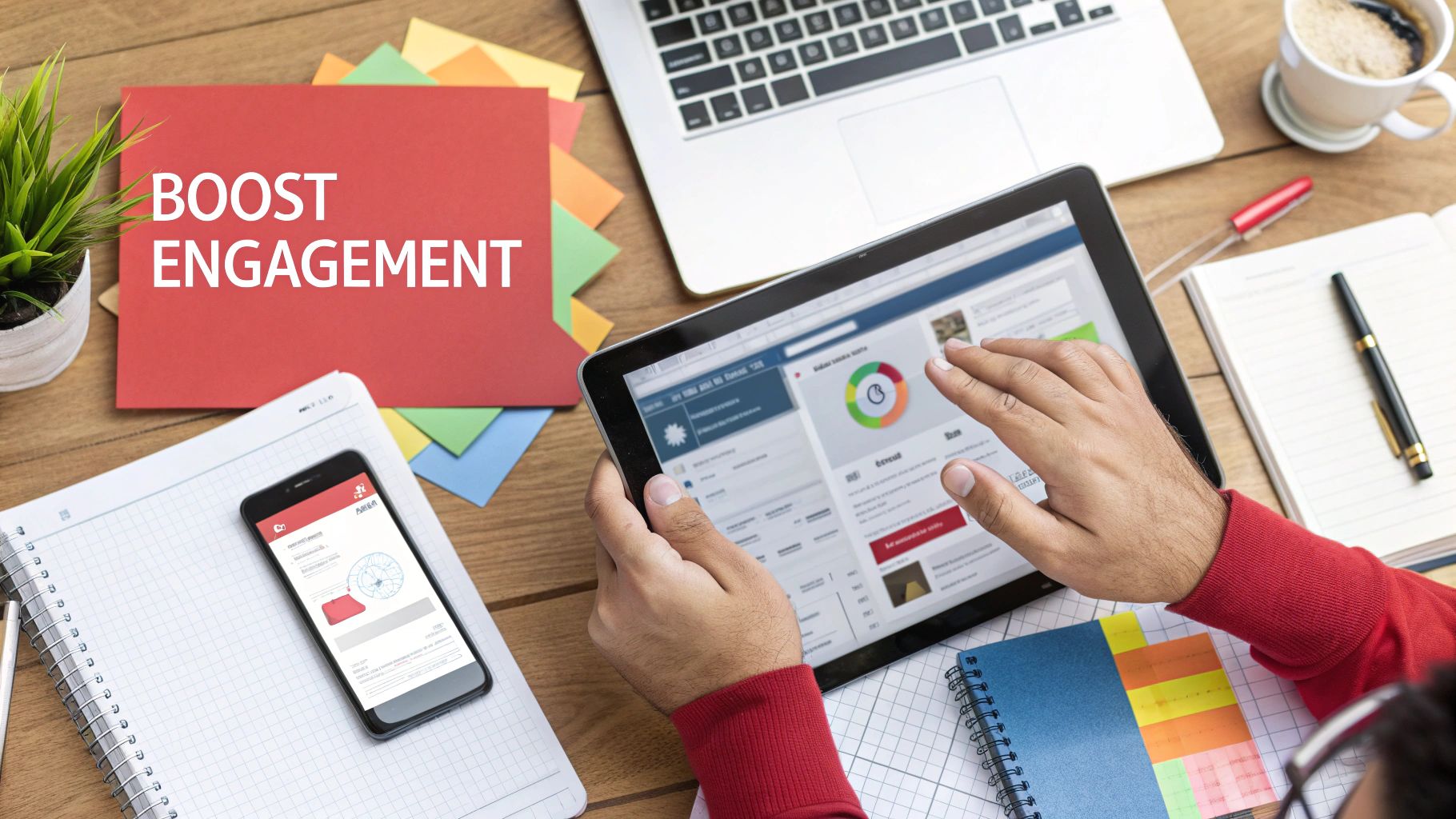
While bringing new customers in the door is important, the real staying power of a business comes from its ability to build lasting relationships. Two of the most effective tools for this are social media and email marketing. These aren't just channels for promotion; they're spaces where you can forge genuine connections with your audience.
Instead of simply broadcasting adverts, social media gives you a place to build a community. It’s where your brand can show its human side, have real conversations, and earn loyalty. In the same way, email marketing opens a direct line to your most engaged customers, letting you nurture them with personal communication from their first flicker of interest right through to becoming a repeat buyer.
Social media as a community hub
Too many businesses still treat social media as just another advertising platform. And while paid ads definitely have their place, the real magic of platforms like Instagram, LinkedIn, or TikTok lies in community building. Think of it less like putting up a poster and more like hosting a party.
The best UK brands use these platforms to create a genuine sense of belonging. They share behind-the-scenes glimpses, respond personally to comments, and encourage their followers to share their own content. This simple shift turns passive observers into active brand advocates who feel truly connected to the business.
This approach is more crucial than ever as social media usage continues to soar. The UK social media ad market is expected to reach £9.95 billion , a figure driven by the 79% of the population —that's 54.8 million people —who are active on these platforms. By focusing on community, you’re tapping into an audience that’s already there and ready to connect. You can explore more on the UK's social landscape and its growth by checking out key statistics and trends on Sprout Social.
Email marketing: The art of personal conversation
If social media is your public square, then email marketing is the private, one-to-one conversation. It continues to be one of the most powerful tools for nurturing leads and retaining customers precisely because it’s so direct and personal.
A social media post is seen by thousands but an email lands in a personal inbox. This gives you a unique chance to speak directly to an individual's specific needs, interests, and where they are in their journey with you. It allows you to segment your audience and send genuinely helpful messages, like a welcome email to a new subscriber or an exclusive offer for a long-time customer.
Email marketing isn't about blasting your list with generic promotions. It’s about delivering real value, building trust over time, and keeping your brand top-of-mind. A great email strategy makes your customers feel seen and understood.
To pull this off, personalisation is everything. Using a customer's name is a start but real personalisation runs deeper. It’s about using data on their past purchases or browsing habits to suggest things they’ll actually want. If you're looking to take your campaigns to the next level, our guide on personalisation in email marketing has practical tips to get you started.
Creating effective campaigns for both channels
To get the most out of social media and email, your campaigns need to be strategic. Just posting at random or firing off a weekly newsletter won't build meaningful connections. You need a more thoughtful approach.
Actionable tips for social media engagement:
- Be consistent: Post regularly to stay on people’s radar but always focus on quality over quantity. A consistent voice and visual style also go a long way in building brand recognition.
- Encourage interaction: Don’t just talk at your audience. Ask questions, run polls, and create content that invites comments and shares.
- Show, don’t just tell: Use video, behind-the-scenes photos, and customer stories to bring your brand to life. It’s far more engaging than a simple text update.
Best practices for email nurturing:
- Segment your list: Group subscribers based on their interests or purchase history. This lets you send much more relevant messages.
- Automate welcome sequences: Set up a short series of automated emails to welcome new subscribers, introduce your brand, and offer immediate value.
- Provide exclusive value: Give your email list something they can’t get anywhere else, like early access to sales, special content, or unique discounts.
- Test and measure: Keep a close eye on your open rates, click-through rates, and conversions. This data tells you what’s working and what’s not, so you can fine-tune your strategy.
How to choose the right marketing solutions
Picking the right digital marketing solutions is a bit like choosing the right vehicle for a journey. A sports car is thrilling but it’s useless for a family camping trip. A campervan is overkill for a quick run to the shops. The perfect choice depends entirely on your destination, your passengers, and your budget.
In the same way, the most effective marketing mix for your business depends on who you are, what you do, and who you’re trying to reach. There’s no single, one-size-fits-all answer but there is always a right fit for you.
Start with your business DNA
Before you can pick the right tools, you have to get brutally honest about your own business. The ideal digital marketing solutions for a local plumber are worlds apart from those for a national B2B software company.
A local plumbing business, for instance, thrives on immediate, local demand. Its main goal is to be found the second a pipe bursts. So, its strategy should be heavily weighted towards Local SEO and targeted Google Ads , making sure it appears at the very top when someone in their area searches for "emergency plumber near me".
On the other hand, a B2B software firm needs to build credibility and nurture long-term relationships. Its focus would shift to in-depth content marketing, like whitepapers and webinars, to establish its authority. It would also invest heavily in LinkedIn marketing to connect with decision-makers in specific industries.
The most common mistake is chasing the latest trend instead of aligning your marketing with your core business model. Your industry, audience, and goals should always be the starting point for your decision-making.
Getting this initial self-assessment right is the bedrock of a successful strategy. It stops you from wasting money on channels that won't deliver a return for your specific situation.
Align solutions with your audience and goals
Once you have a firm grip on your business identity, the next step is to map out your specific objectives. Are you trying to generate immediate leads, build long-term brand awareness, or drive foot traffic to a physical shop?
Each goal points towards a different set of digital marketing solutions.
- For immediate lead generation: If you need to fill your sales pipeline fast, Pay-Per-Click (PPC) advertising is your most direct route. It delivers quick, measurable results by targeting users who are actively searching for what you offer.
- For building brand authority: If your goal is to be recognised as a thought leader, Content Marketing and SEO are non-negotiable. This approach builds trust and organic visibility over time, attracting a loyal following.
- For local customer engagement: For businesses serving a specific area, Local SEO and location-targeted Social Media Marketing are critical for connecting with the local community.
- For nurturing customer relationships: To keep existing customers and encourage repeat business, Email Marketing offers a direct, personal line of communication for delivering value and exclusive offers.
Understanding this alignment prevents a scattergun approach where your budget is spread too thinly across too many channels. Instead, you can focus your efforts where they will have the most significant impact.
To help you visualise this process, this decision tree shows how different business factors can guide your choice of analytics tools—which are fundamental for measuring success.
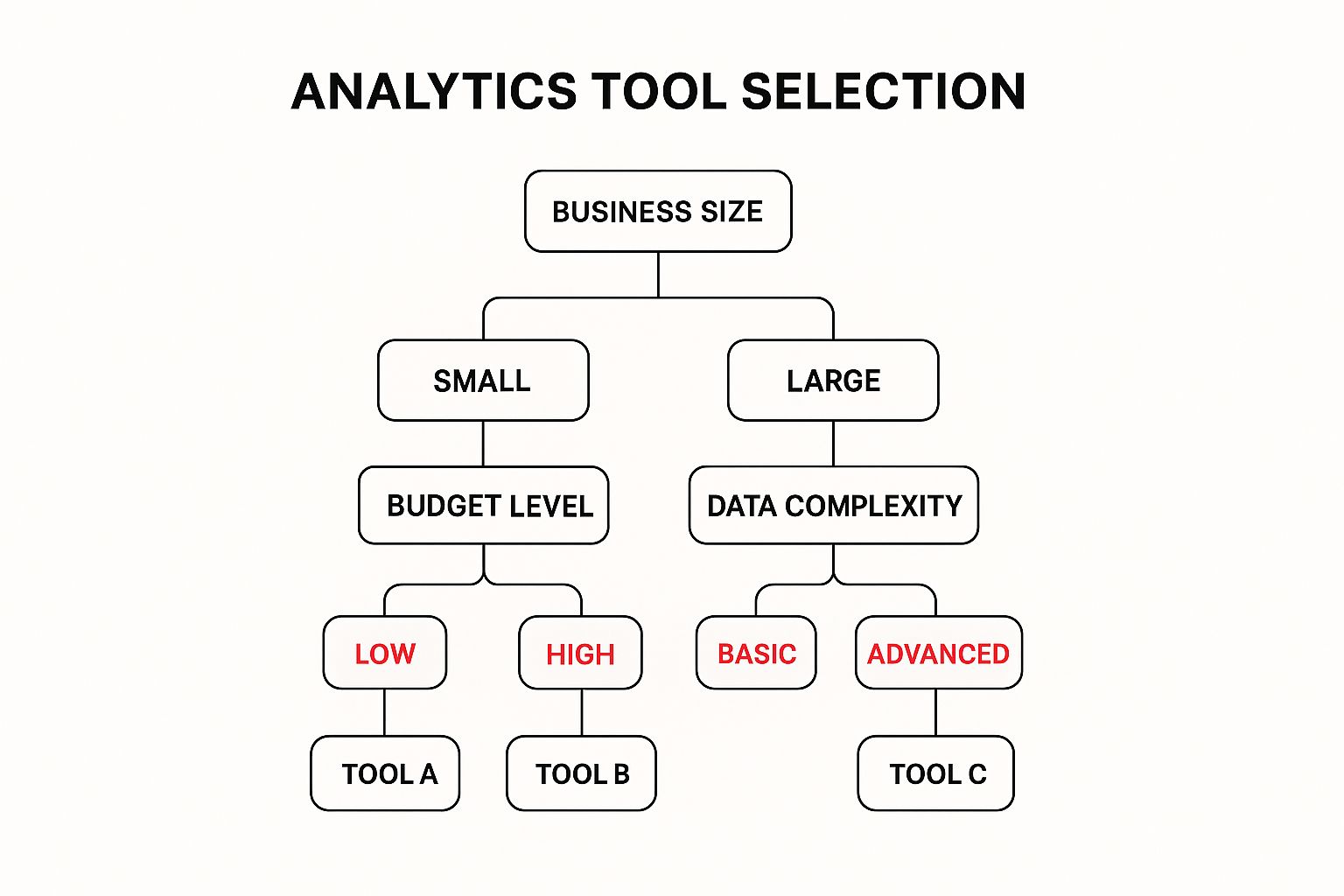
As the infographic highlights, there's no single 'best' tool—only the best tool for a specific context, whether that’s a small business on a tight budget or a large enterprise managing complex data.
Matching business goals to marketing solutions
With a clear picture of your business, your audience, and your goals, you can start making some smart choices. To simplify things, the table below maps common business scenarios to the marketing solutions that make the most sense.
| Business Goal | Recommended Primary Solution | Recommended Secondary Solution | Best For (Business Type) |
|---|---|---|---|
| Generate Immediate Local Leads | Local SEO | Google Ads (PPC) | Service-based businesses (e.g., electricians, trades) |
| Build National Brand Authority | Content Marketing | Organic Social Media | B2B companies, professional services, consultants |
| Drive E-commerce Sales | Social Media Advertising | Email Marketing | Online retailers, direct-to-consumer (D2C) brands |
| Increase Footfall to a Store | Google Business Profile Optimisation | Location-based Ads | Restaurants, retail shops, cafés |
| Nurture High-Value B2B Leads | LinkedIn Marketing | In-depth Webinars | Software-as-a-Service (SaaS) and technology companies |
Think of this table as a practical guide to help you cut through the noise and find a logical starting point. By matching your unique circumstances to the right set of tools, you can build a marketing strategy that is not only effective but also efficient and sustainable.
Measuring your marketing success and ROI

A digital marketing solution is only as good as the results it delivers. Investing time and money into SEO, content, or social media without a clear way to measure success is like driving with your eyes closed. You might be moving but you have no idea if you’re heading in the right direction.
This is where measurement and return on investment (ROI) come into play.
Proving the value of your marketing efforts is essential. It’s how you justify your budget, show stakeholders the impact of your work, and make smarter decisions about where to put your resources next. Without data, you’re just guessing. With it, you have a clear roadmap for growth.
Defining your Key Performance Indicators
Before you can measure success, you first need to define what success actually looks like for your business. This is done through Key Performance Indicators (KPIs) —specific, measurable metrics that track your progress towards a goal.
Think of each marketing solution as having its own unique scorecard. The numbers on that card tell you if you’re winning the game for that specific channel. Naturally, the KPIs you track will vary depending on the solutions you're using.
For example, your scorecards might include:
- For SEO: Focus on organic traffic growth to see how many more people are finding you through search. Also, keep a close eye on keyword rankings for your most important terms.
- For PPC advertising: The most critical KPI is often conversion rate , which tells you how many clicks are turning into actual leads or sales. Cost per acquisition (CPA) is also vital for understanding how efficiently you’re spending your budget.
- For social media: Look at the engagement rate (likes, comments, shares) to see how your content is resonating. For paid campaigns, track the click-through rate (CTR) .
Selecting the right KPIs ensures you’re focusing on what genuinely impacts the business, not just vanity numbers. When it comes to social media, a critical step is proving social media ROI by connecting your activity directly to business outcomes.
Tracking and analysing your data
Once you know what to measure, you need the right tools to track it. For most businesses, Google Analytics is the central hub for monitoring website performance. It provides a huge amount of information about where your traffic comes from, how people behave on your site, and which channels are actually driving conversions.
Setting up goals in Google Analytics is a non-negotiable step. This allows you to track specific actions—like form submissions, downloads, or purchases—and trace them back to the marketing channel that brought the visitor to your site. This is how you start connecting your marketing activities to tangible business results.
Data shouldn't just be used for reporting on the past. Its real power lies in using those insights to refine your future strategies for continuous improvement and better results.
This means regularly reviewing your dashboards and looking for patterns. Is one blog post driving a massive amount of organic traffic? Perhaps you should create more content on that topic. Is a particular ad campaign delivering a low cost per acquisition? It might be time to increase its budget.
Calculating your return on investment
Calculating ROI is the ultimate measure of marketing effectiveness. It answers the most important question of all: for every pound we spend on marketing, how much are we getting back?
Thankfully, the basic formula is straightforward. To calculate your ROI, you just need two key figures:
- Gain from investment: The total revenue generated from your marketing activities.
- Cost of investment: This includes your ad spend, software subscriptions, and any agency fees.
The simple ROI formula is (Gain from Investment - Cost of Investment) / Cost of Investment . Multiply the result by 100 to get a percentage. For instance, if you spent £1,000 on a campaign that generated £5,000 in sales, your ROI would be a very healthy 400% .
Demonstrating a positive ROI is the clearest way to show the value of your chosen digital marketing solutions. It moves the conversation from marketing being a cost centre to it being a powerful revenue driver. For a deeper dive into this, explore our guide on maximising ROI with multi-channel marketing.
A few common questions we hear
Even with a clear path forward, it’s natural to have a few lingering questions. Let's tackle some of the most common ones we hear from business owners, just to clear up any final uncertainties.
How much should a small UK business really budget for marketing?
There’s no magic number here. The right budget really depends on your industry, how fierce the competition is, and what you’re trying to achieve. But as a solid rule of thumb, most small businesses find success by allocating between 7-12% of their total revenue to marketing.
If you’re just starting out, a budget of around £500-£2,000 per month is a realistic place to begin. This lets you go all-in on one or two channels that pack a punch, like local SEO or a super-targeted social media ad campaign. The trick is to start smart, track what’s working, and then double down on the winners. It's always better to dominate one channel than to sprinkle a small budget too thinly across several.
The best digital marketing solutions aren't always the priciest. A smaller, well-aimed budget that you measure obsessively will almost always beat a large, unfocused spend. It’s not about the size of the budget; it’s about how cleverly you use it.
This focused approach makes sure every pound you spend is working its socks off for your business.
What’s the real difference between SEO and PPC?
Both SEO (Search Engine Optimisation) and PPC (Pay-Per-Click) want to get you noticed on search engines but they go about it in completely different ways. Getting your head around this is key to using them properly.
SEO is all about optimising your website to climb the rankings in the organic (unpaid) search results. Think of it as a long-term play to build genuine authority and create a steady, sustainable stream of visitors. You’re essentially earning your spot at the top by being the best, most relevant answer.
PPC , on the other hand, is about paying for placement. Using services like Google Ads , you can bid on keywords to appear right at the top of the search results, instantly. It’s fantastic for getting immediate traffic but that visibility vanishes the second you stop paying. A great strategy often uses both: PPC for quick wins and valuable data, while SEO quietly builds your long-term, cost-effective growth in the background.
How long until I actually see results?
This is the big one, and the honest answer is: it depends on the channel. Some tactics give you an almost immediate hit, while others are more of a slow burn that requires patience.
- Pay-Per-Click (PPC): This is your sprinter. A well-built campaign can be live and driving traffic to your site within hours. You get results almost straight away.
- Social media marketing: You can see initial engagement—likes, comments, shares—pretty quickly, often within days. But building a genuinely loyal and engaged community takes a few months of consistent, quality content.
- Search Engine Optimisation (SEO): This is your marathon runner. While you might spot small improvements early on, it generally takes a good 4-6 months to see meaningful shifts in your rankings. The really significant, business-changing results often start showing up after 6-12 months of dedicated effort.
Knowing these timelines helps you set realistic expectations. A balanced strategy isn't about choosing one over the other; it's about blending short-term tactics with long-term investments to build something that lasts.
Are you ready to build a digital marketing strategy that delivers real results? The team at Superhub specialises in creating bespoke digital marketing solutions for businesses in motorsport, automotive, and beyond. We combine strategy with data-driven execution to help you achieve your growth goals. Start your journey with us today.

